The tao that can be told
is not the eternal Tao.
The name that can be named
is not the eternal Name
The unnamable is the eternally real.
Naming is the origin
of all particular things.
Free from desire, you realize the mystery.
Caught in desire, you see only the manifestations.
Yet mystery and manifestations
arise from the same source.
This course is called darkness.
Darkness within darkness
The gateway to all understanding.
Lao-tzu, in chapter one of the Tao Te Ching, ( Stephen Mitchell’s translation) presents the Tao’st non-dual vision succinctly and mysteriously. The ‘realization’ of the Truth underlying the Tao Te Ching is also the goal of yoga. To paraphrase Lao-tzu, ‘Being’ and ‘Becoming’, two radically different and totally essential perspectives from which life can be experienced, are actually expressions of fundamental wholeness. Being (mystery for Lao-tzu) is a synonym for ‘Infinite Stillness’, ‘Now’, ‘Purusha’ etc. Being (unexpressable in words, but we try anyway!) is unbounded, unlimited, unchanging pure potentiality, resting as pregnant stillness. And all is “I’, I am. There is no ‘other, which is the fundamental premise of the non-dual view.
Becoming (manifestations) refers to the evolutionary journey of the cosmos evolving and complexifying through time, expressing itself in the form of quarks and galaxies, fields and flow and everything else, imaginable and yet to be imagined; and of course, our own moment to moment unfolding in time and space, constantly changing, ever mysterious. Non-Dual vision refers to a life grounded in the knowing that both points of view are part of a whole ‘Self’, and need to be cultivated and integrated to lead a spiritually fulfilling life. The challenge in awakening and remaining awake is to hold both perspectives simultaneously, moment to moment, understanding what each offers as we respond to our unfolding life adventure.
The reality is however that ‘Being’ is elusive. Living only from ‘Becoming’, the ever-changing world of manifestation, leads to what Pema Chodron calls the essential 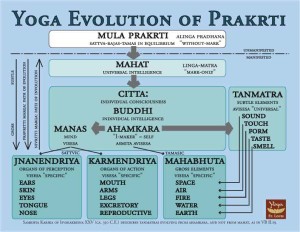 ambiguity of the human condition. We all crave a stability of ‘well being’, but this cannot be found in a world of continuous ‘Becoming’. Somewhere along the line we decide that ‘well being’ means always have things go the way we want them to, which means much of life is seen as alien, or other.
ambiguity of the human condition. We all crave a stability of ‘well being’, but this cannot be found in a world of continuous ‘Becoming’. Somewhere along the line we decide that ‘well being’ means always have things go the way we want them to, which means much of life is seen as alien, or other.
The ahamkara, the Samkhya term for the aspect of mind that develops strategies for making the world conform to our wishes. This requires constantly managing our likes and dislikes, which themselves are always changing. These strategies crystallize as various selves or voices, also known as ego. Vast amounts of mind activity is spent by these dualistic voices in our heads complaining about how the universe is not flowing the way we want it to, right now. If it doesn’t make me feel good, it is ‘not me’, and either useless or dangerous. To a dualistic mind, the world is overwhelmingly ‘not me’. (Citta vrtti nirodhah, anyone?)
However, inevitably, various trivial yet unavoidable irritations like mosquito bites, traffic jams and ‘other people’ intrude on our sense of well being. At a deeper level, whether we consciously acknowledge it or not, we all know that our own death is inevitable, some day. So are all other sorts of loss, such as the death of friends and family, loss of jobs, homes, and friendships, divorce and other relational traumas.  We just never know when, we have no control over these phenomena, and often no way to even see them coming. (Sadly, literally and ironically, as I was writing this paragraph, this beautiful old oak tree in our back yard gave up the ghost.) And we (our dualistic voices or selves, posing as us) hate this! We want stability and security that a constantly changing world can never provide. Our various ‘selves’ try defend themselves by grabbing onto the good stuff and fighting off the bad.
We just never know when, we have no control over these phenomena, and often no way to even see them coming. (Sadly, literally and ironically, as I was writing this paragraph, this beautiful old oak tree in our back yard gave up the ghost.) And we (our dualistic voices or selves, posing as us) hate this! We want stability and security that a constantly changing world can never provide. Our various ‘selves’ try defend themselves by grabbing onto the good stuff and fighting off the bad.
Buddha made this struggle to fortify and defend our self-sense against the reality of being the first of his ‘Four Noble Truths’ and called it dukha or suffering. These various dualistic ‘selves’ posing as the true ‘I am’ find security by fixating on ideas, beliefs and strategies about what makes us ‘feel good’ and what makes us feel bad. This inhibits flow and it is this ‘fixation’ that is the cause of 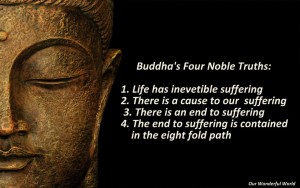 suffering.
suffering.
Ultimately, this fixation is because the dualistic mind hates ambiguity. It (we) wants our truths simple and absolute, which is, of course, fundamentalism. We see this story being played out across the planet, in religion, politics, economics, education and more. President Trump is a fairly extreme version of the fixated, dualistic mind gone wild, but we all have a bit of Trump in us.
Most students who walk into a yoga class do not want ambiguity. They want to know ‘how to do the pose the right way’. We all hope yoga will offer a safe haven from the vicissitudes of life. It will, if we can take on the non-dual view. As inhabitants of a constantly changing body/mind vehicle, at a core level, we all begin as fundamentalists. But a somatic practice is a profoundly effective path to unraveling these fixations. Although our psychological and emotional ones can easily remain unseen, in the ‘shadow’ aspect of our unconscious, the physiological and physical stuck spots become immediately apparent as soon as we begin working with asana. The breath has constrictions and the muscles, joints and connective tissues have knots and blockages galore.
The dualistic mind wants to ‘get rid of’ these blockages, because they are painful, or even embarrrassing if their limitations rub up against a ‘yoga self image’ of being open and flexible. And there very well be some stored trauma that needs careful therapeutic processing. If we have a ‘fixed belief’ that the fixations are a problem to be removed, the fixations remain ‘other’ and the dualistic mind will never find freedom. However, it is possible not to get stuck here, and that is the true goal of any spiritual practice. If we can learn to see these stuck places as our teachers, guides and sources of potential growth welcome them with an open heart, a whole new realm awakens. And here is where the kidneys can be of great service to us.
As yogi-somanauts exploring the layers and levels of aliveness in our cells, fluids and organs, we occasionally discover regions that are involved with integrating many levels of life activity. Lately the cosmos has had me spending time with the kidneys, and wow, is this an amazing place to play, because the kidneys are masters of non-dual awareness!
Amazingly enough, the kidneys, as understood in Chinese Medicine, are totally at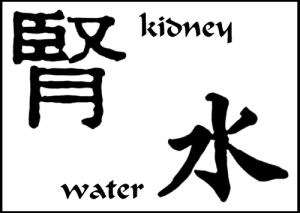 home in ambiguity because they are true Tao’ists. They rest in ultimate mystery while they act in life. As the guardians of the water element in the body, they know flow. They accept the moment as it is, and simultaneously, apply untold millions of years of intelligent learning and experience to respond to the needs of the moment. Organic well being is their goal, but realize that this is not a fixed place.
home in ambiguity because they are true Tao’ists. They rest in ultimate mystery while they act in life. As the guardians of the water element in the body, they know flow. They accept the moment as it is, and simultaneously, apply untold millions of years of intelligent learning and experience to respond to the needs of the moment. Organic well being is their goal, but realize that this is not a fixed place.
Chinese medicine is based on the non-dual wisdom of Taoism and looks to sustain a deep harmony with all levels of reality, manifest and unmanifest. If we can begin to tune into our kidney energy and the kidney fields as they operate in our moment to moment life processes, they can help us to embody the non-dual capacity to embrace ambiguity and awaken to the organic intelligence of life itself.
As a starting point the anatomical kidneys, sitting at the center of the body offer us accurate reference points to help bring feeling and perception to the deeper tissues and fluids in this key region of the body. Using breath and imagination, we can track the subtle movements (and restrictions!) of the kidneys in the three spatial dimensions. The easiest is as they move up and down following the diaphragm. Front and back, or right and left are more subtle. These spatial polarities are included in what Patanjali calls the dvandvas, the pairs of opposites that are integrated through the practice of asana. (II-48 tato dvandva anabhigatah). It is also through this integration of opposites that rajas (action) and tamas (rest) lead to sattva, the state of transparent harmony that allows non-dual insight to arise. (Later in this article we will see how rajas and tamas are analogous to the yang and yin of Tao’ism.)
In the Tao’ist model, all manifestations, or creation, arise as combinations of two primary qualities of existence known as yin and yang, representing the basic principles of inter-connectedness and constant change. As depicted in the well known symbol above, yin and yang can not be separated, and yet they appear to be opposite to each other. Yin cools, yang heats. Yin condenses, yang expands. Yin represents the feminine and all the qualities of Mother Earth. Yang represents the masculine and the qualities of Father Sky, the heavens or celestial realms. They are in an intimate relationship with each other, working as one to maintain a balance that allows creation to thrive.
Yin and yang perfectly describe the paradox of biology and aliveness itself. Life is ambiguous, sustaining itself by constantly hovering in a narrow band between too much and not enough. Variables like temperature are fairly straight forward. You can die from hypothermia, or excess fever so the body constantly adjusts its processes to balance the elements of fire (heating/yang) and water (cooling/yin) keeping the temperature at 98.6 degrees F. Most biological systems, however involve far more complex relationships involving psychological, emotional and metabolic processes with proteins, waste products, hormones, neurotransmitters, nutrients and more. But ultimately, a successful life comes down to balancing yin and yang at every possible level.
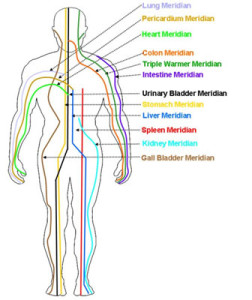 The kidneys are one of the twelve “organs” described in Chinese Medicine. There are 6 categorized as yin, involved with supporting and nourishing, with each of these paired with one of 6 yang organs involved with dynamic action. These ‘organs” are not exactly the organs aswe know in Western Medicine. Rather, they represent complex sets of relationships, interactions and modulations centered on the physical organ and the physiology recognized in the west, but also spreading out through the whole being in subtle and surprising ways. Each organ has an associated meridian line with numbered ‘cavities’ where acupuncture needles can be inserted to stimulate the inner system.
The kidneys are one of the twelve “organs” described in Chinese Medicine. There are 6 categorized as yin, involved with supporting and nourishing, with each of these paired with one of 6 yang organs involved with dynamic action. These ‘organs” are not exactly the organs aswe know in Western Medicine. Rather, they represent complex sets of relationships, interactions and modulations centered on the physical organ and the physiology recognized in the west, but also spreading out through the whole being in subtle and surprising ways. Each organ has an associated meridian line with numbered ‘cavities’ where acupuncture needles can be inserted to stimulate the inner system.
In Chinese Medicine, the kidneys play a foundational role. Kidneys are a ‘yin’ organ and associated with grounding, cooling, receiving. But, as this is a Tao’st system, kidneys have both yin and yang qualities and energies, (as do all of the organ systems).
Kidneys represent the water element and are said to be the ocean of the human body. The oceans sit at the lowest place on the earth and waters of the lakes, rivers and streams flow down to rejoin them. The sun (Fire) evaporates the ocean water, converting it to mist clouds and rain, which fall back to earth filling the lakes rivers and streams and continuing the cycle.
Kidney yin, also called primordial yin, true yin or true water, is the foundation of the yin fluid of the whole body; it moistens and nourishes the organs and tissues. Kidney yang, also called primordial yang, true yang or true fire, is the foundation of the yang qi of the whole body; it warms and promotes the functions of the organs and tissues. Thus the yin/yang balance of each organ depends upon the yin/yang balance of the kidneys.
The kidneys store also ‘jing’ or essence (there is no real western word to cover this). Jing is the primordial substance before yin and yang emerge and is said to be the seed of the life process. Pre-natal jing comes from the egg and sperm of the parents, and we might say jing involves the unique expression of the DNA and becomes a core part of a persons constitution. Adding to this in the post-natal jing, the life force essence derived from what is absorbed from the environment, including food, but also psychological, emotional and spiritual energies.
Jing or essence is not a substance but a quality or potential for growing, maturing and evolving that differentiates the living from the non-living forms of the universe. With healthy jing we age gracefully and consciously. Jing is the source of reproduction and as kidneys store jing, they have an intimate relationship with the genital organs. The kidneys and gonads emerge from the same tissues embryologically, so this is no surprise. It truly seems that the Tao’ists who first articulated the principles of Chinese Medicine had an intimate and intuitive connection to the embryological development process.
There is also a strong shamanic link to the kidneys as they connect us to our ancestors. Not only through the obvious action of the genes, but the subtle energy fields as well. My cranio-sacral guru is helping me track my paternal lineage karma through my right kidney and I am working to heal some old wounds carried for many generations by my Irish ancestors.
Jing is said to produce marrow so kidneys ‘rule the bones’. The ‘inner sea of marrow’ also includes the brain and spinal cord, so healthy kidneys lead to a healthy brain. The ears are the ‘outer opening to the kidneys’ through the sea of marrow and the brain.
Kidneys ‘grasp the qi’, which means that during the inhalation the kidneys help draw the breath into the lungs and down to the pelvic region. (We will practice this later.) Kidneys also store the ‘will’. Yang will is the dynamic assertive quality of being. Yin will is noticed in stillness, resting in irreducible mystery, or being deeply connected to the unknown and you will see an extraordinary demonstration of kidney yin later in the post.
Finally, the kidneys ‘dominate anterior and posterior orifices’, the anus and the uro-genital openings. In addition to the previously mentioned reproductive capacities, the kidneys also have water relationships with the bladder and large intestine, the two yang organs involved in excretion. Dysfunction in here may be traced back to kidney deficiencies. In the practice section, we will explore this relationship in a variation of our micro-cosmic orbit meditation we introduced in a previous post by attending to the seat of the yin at CV 1.
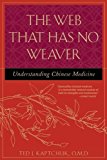
(An excellent introduction to the mysteries of Chinese Medicine and the source of most of this overview is ‘The Web That Has No Weaver’ by Ted Kaptchuk. Also essential to my understanding is my weekly sessions with my TCM teacher, John Hickey.)
Explorations in Energy-Flow Meditation:
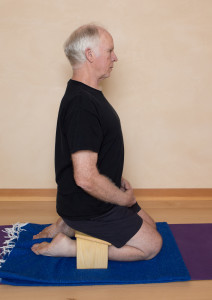 Using the diagram below as a map, in any sitting posture, first establish your core line, using your breath and imagination to connect heart center with crown (GV-20) and the heavens, and root chakra (CV-1) and the earth. The center your awareness at CV-1 the seat of the yin, at the center of the perineum. You may feel this as a simultaneous and subtle tucking and untucking energy flow that meets and balances here. Let this point extend down into the ground on inhalation and spring back up on the exhalation, cultivating elasticity.
Using the diagram below as a map, in any sitting posture, first establish your core line, using your breath and imagination to connect heart center with crown (GV-20) and the heavens, and root chakra (CV-1) and the earth. The center your awareness at CV-1 the seat of the yin, at the center of the perineum. You may feel this as a simultaneous and subtle tucking and untucking energy flow that meets and balances here. Let this point extend down into the ground on inhalation and spring back up on the exhalation, cultivating elasticity.
Now, imagine/feel that on the inhalation, the downward breath flows through 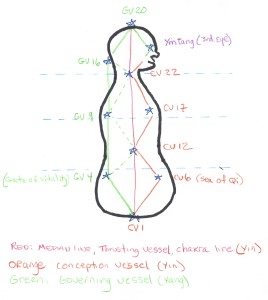 GV-4, down to CV-1 and around the corner and up to CV-6. Let the exhalation reverse this pathway. After several breaths reverse the whole pattern. On the inhalation, feel the breath/energy flowing through CV-6 to CV-1, around the corner and up to GV-4; on the exhalation, reverse. Then, pause and rest in the stillness at the center of the balanced energy field.
GV-4, down to CV-1 and around the corner and up to CV-6. Let the exhalation reverse this pathway. After several breaths reverse the whole pattern. On the inhalation, feel the breath/energy flowing through CV-6 to CV-1, around the corner and up to GV-4; on the exhalation, reverse. Then, pause and rest in the stillness at the center of the balanced energy field.
These are major points for kidney yin and yang and begin to awaken what is called the lower dantian, the energy field of the lower third of the body and the root of embodied existence. No thoughts arise here. Just energy and presence. (The middle dantian is centered around the heart and the upper dantian around the midbrain. See the diamonds in the illustration above.) As described in the previous post, you can add more points to your meditation/flow tracking to explore the whole circuit. To work physiologically, as you travel back and forth through CV-1, from CV-6 to GV-4, feel both the anal and urogential regions softening and relaxing away from the center, allowing blood flow, space and presence. Visualize all of the pelvic organs breathing freely, bathing in the sea of qi. Feel the connection to the kidneys. Feel lateral space as well.
Now shift your attention, using this foundation, and begin to imagine the kidneys and lungs working together. “Grapsing the qi” feels like the descending kidneys help open the lower back lungs to have a fuller in-breath, as the back diaphragm expands and lengthens downward as well. On the exhalation, maintain the rooted feeling even as the kidneys and diaphrgam rise back up to keep the lift of the heart. In embryology, the final kidneys (the are two other sets of proto-kidneys that disappear during development) begin in the pelvis. Interestingly enough, they remain where they are and the whole lower body including the lumbar spine and pelvis grows downward, leaving the kidneys where we find them today. (see diagram above) Finally, play with the points and patterns in the above diagram in any way your intuition and imagination allows. Let it come alive for you in your own unique way.
Somatic Explorations
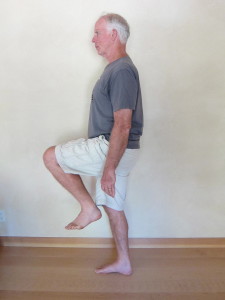 Embodying kidney yin and yang: From the foundation of the above practices, bring this awareness to standing. In tadasana, as you bring one knee up, feel the kidney on that side descending and the back muscles softening, without collapsing the front body. This is awakening the kidney ‘yin’. If you do this on an inhalation, feel the kidney ‘grasping the qi’
Embodying kidney yin and yang: From the foundation of the above practices, bring this awareness to standing. In tadasana, as you bring one knee up, feel the kidney on that side descending and the back muscles softening, without collapsing the front body. This is awakening the kidney ‘yin’. If you do this on an inhalation, feel the kidney ‘grasping the qi’ 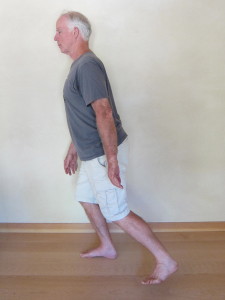 and track the breath down into the pelvis.
and track the breath down into the pelvis.
As you extend the leg back without tightening the spinal muscles, land on K-1 and feel the front of the kidney opening and the yang kidney energy rising up, If the spinal muscles contract, you are not releasing the kidneys. To complete this action, allow your heel to land as well, not by pushing the knee back, but by releasing the yin kidney energy down with the heel. Feel the kidney-heel connection.
Using a wall for balance, try this in ardha chandrasana. From the full pose, bring the top leg toward the chest and feel the release of the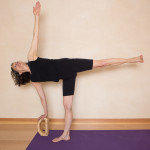 lower back muscles. Go deeper. Feel this as the kidney yin energy releasing down into the pelvis and the lower dantian. When you extend the leg back to its final position, extend from the energy of the dantian/kidneys and not by overworking the muscles. This will feel fluid and effortless.
lower back muscles. Go deeper. Feel this as the kidney yin energy releasing down into the pelvis and the lower dantian. When you extend the leg back to its final position, extend from the energy of the dantian/kidneys and not by overworking the muscles. This will feel fluid and effortless.
An extreme kidney yin pose is child pose, a very quieting posture that, if your knees allow, creates a cooling and 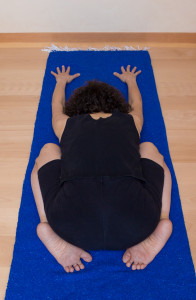 deeply quiet interior. Bring you attention to your kidneys and visualize them softening, cooling, resting. Do not struggle with the muscles. Support yourself as necessary. If you knees do not allow such deep flexion, you can do this pose sitting on a chair and resting your head on a desk, table or second chair.
deeply quiet interior. Bring you attention to your kidneys and visualize them softening, cooling, resting. Do not struggle with the muscles. Support yourself as necessary. If you knees do not allow such deep flexion, you can do this pose sitting on a chair and resting your head on a desk, table or second chair.
All forward bending postures, if down without collapsing the front body, cultivate the cooling kidney yin energy. Uttanasana, because the legs are extending (yang), will be less cooling than child pose, and you can see the possible spectrum available with the different forward bending poses. These postures are very helpful in the heat of the summer.
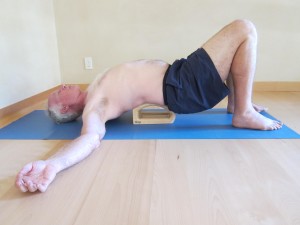 Backbends, in contrast, awaken kidney yang, if done without tightening the spinal muscles. The kidney organs still flow down toward the pelvis to root the core energy and support the base, but the front of the kidneys open and release the energy trapped in the connective tissues of the mesentery and blood vessels. this flows up to help open the heart. The kidney yin is still present to balance the overall tone. In this pose the knees and hips are flexed, adding a bit more yin to the pose. The Bhoga block sits right under the kidney region to act as a fulcrum to balance yin and yang, up to the heart and down to the pelvis. There is an old constriction at the root of the skull leading to the color shift at the throat.
Backbends, in contrast, awaken kidney yang, if done without tightening the spinal muscles. The kidney organs still flow down toward the pelvis to root the core energy and support the base, but the front of the kidneys open and release the energy trapped in the connective tissues of the mesentery and blood vessels. this flows up to help open the heart. The kidney yin is still present to balance the overall tone. In this pose the knees and hips are flexed, adding a bit more yin to the pose. The Bhoga block sits right under the kidney region to act as a fulcrum to balance yin and yang, up to the heart and down to the pelvis. There is an old constriction at the root of the skull leading to the color shift at the throat.
In supported ustrasana/supta virasana there is a stronger action on the kidneys, so more 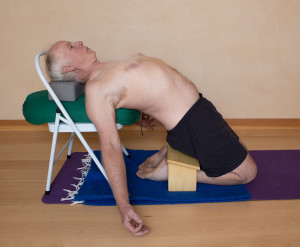 attention is required to keep the glutes engaged to help the kidney yin flowing down stream to the seat of the yin at CV-1. Because this is supported, it is a more yin pose than unsupported, and can actually allow a deep resting in stillness.
attention is required to keep the glutes engaged to help the kidney yin flowing down stream to the seat of the yin at CV-1. Because this is supported, it is a more yin pose than unsupported, and can actually allow a deep resting in stillness. 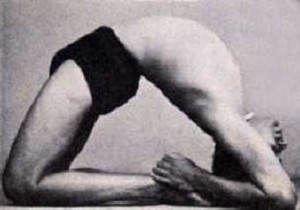
“My kapotasana is just like your savasana!” One of my all time favorite quotes, and I was there watching. B.K.S. Iyengar, in the middle of an asana demonstration at Sanders Theater, Cambridge, MA, 1987. Although a fiery guy, he knew how to utilize his kidney yin will to deepen stillness, even in dynamic poses.
One crucial thing I have learned in the past year is that healthy kidney yin helps lower the blood pressure. Too much kidney yang and not enough kidney yin raises the blood pressure. I have my home blood pressure kit to verify this.
Twisting Poses affect the kidneys in differing ways, depending on what else is going on in the posture. As an example, this simple standing twist using the wall becomes a very different pose by adding a little more kidney yin action.
As an example, this simple standing twist using the wall becomes a very different pose by adding a little more kidney yin action.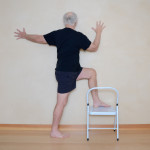 With the bent front knee and the foot supported, the pose becomes standing marichyasana, one of the key postures used in the therapeutic classes in Pune.
With the bent front knee and the foot supported, the pose becomes standing marichyasana, one of the key postures used in the therapeutic classes in Pune.
In any twists of your choice, notice the way the kidneys move apart and together with the breath. Notice if one has more space and movement and try to balance them. Any in any poses, from sirsasana to savasana say hello to your kidneys. Let them speak to you, and teach you about balance and ultimate stillness.

